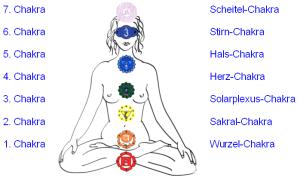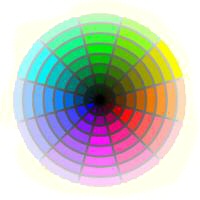Chakras and Colours (Well-being)The 7 Main ChakrasChakra is a Sanskrit word meaning "wheel". The chakras are the sense organs of the subtle realms. According to their size and vibration, they are responsible for the ways in which we think or feel. Their vibrational value ist nothing other than the degree of the development of our consciousness determining the energy quality that can be absorbed and processed by the chakras. In turn, this energy quality influences the chakra's function and development. Each chakra consists of a certain number of spokes or "petals". As each chakra absorbs different cosmic energies, the number of the petals differs correspondingly. Knowledge of the chakras is a further important element in the manufacture of our products and forms an integral part of our therapeutic applications in order to achieve the utmost possible integral development and growth of consciousness. The 7 rainbow colours correspond to the 7 main glands with their respective energy centres, the chakras. 1st CHAKRA
1st CHAKRA
The first chakra is situated between the genitals and the anus. The colour is red. The pertinent symbol is the 4-petalled lotus. The element is earth. The sense function is "smelling" and the related gland is the suprarenal body. 2nd CHAKRAThe second chakra is situated about 2 fingers’ breadth below the navel, at the level of the sacrum. The colour is orange. The symbol is the 6-petalled lotus. The element is water. The sense function is "tasting". The related glands are the reproductive glands (ovaries, prostate gland and testicles). 3rd CHAKRAThe third chakra is about 3 to 4 cm above the navel. The colour is yellow or golden yellow. The symbol is the 10-petalled lotus. The element is fire. The sense function is "seeing". The related gland is the pancreas. 4th CHAKRAThe fourth chakra is situated at the mid-chest or solar plexus. The colours are green, roseate and magenta. The symbol is the 12-petalled lotus. The element is air. The sense function is the tactile sense. The related gland is the thymus. 5th CHAKRAThe fifth chakra is situated at the throat level. The colour is light-blue and/or aquamarine. The symbol is the 16-petalled lotus. The element is ether. The sense function is "hearing". The related gland is the thyroid. 6th CHAKRAThe sixth chakra is between the eyebrows. The colour is indigo-blue. The symbol is the 96-petalled lotus. The sense function is "psychical perception". The related gland is the pituitary gland (hypophysis). 7th CHAKRAThe seventh chakra is at the crown of the head. The colours are violet, white and golden. The symbol is the 1000-petalled lotus. The related gland is the pineal gland. The crown chakra respresents the connection to the "Higher Self": it is the gateway to the Cosmic Consciousness and to complete wisdom. The ColoursLight and colour form a unity: without light, there would be no colour. Rays of light descending upon matter are reflected by it. This kind of radiation - depending on its wavelength - appears to the human eye as a certain colour. 
Modern theories of colours are based on the principles of Goethe's theory of colours. Goethe himself considered the research of colours to be his lifework, attaching greater importance to this than to his literary achievements. He stated the existence of three pure colours, i.e., red, yellow and blue, with the other colours being combinations of these primary colours: if these three colours are mixed in equal parts, first quality colour combinations will result: - e.g. red and yellow will yield green; blue and red will yield violet. The colours facing each other in the colour disc are called complementary colours.
"Nature! We are surrounded and embraced by her - not able to step out of her, not able either to enter more deeply into her. Unasked and unwarned, she takes us up in the circle of her dance, driving us on in her embrace until we are exhausted, then slipping from her arms. Eternally, she creates new forms; what is there has never been; what was, is never to appear again - all is new, yet remaining old. We live in her midst, yet are still alien to her. Incessantly, she communes with us, yet never reveals her secret. Though acting upon her unceasingly, we still hold no power over her." The Colours of our Glass Products and their MeaningsRED is the colour of strength, health and vitality - the power to act and to experience elation (in the positive as well as in the negative sense). Red is the colour of the earth, thus of being "grounded". ORANGE acts mildly, has a regenerating, invigorating and positive character, is cheerful in every respect and salubrious. This colour is inspiring and stimulating. GOLD-TOPAZ is the colour of the sun, of balanced force and abundance. YELLOW offers a more moderate warmth, is of a balancing character, but of strong intensity. Yellow helps with learning, and among other things, activates the left cerebral hemisphere, bringing light into life. LEMON has similar potentials as yellow, but thanks to its clarity, it also activates the spiritual parts of man. LIME-GREEN may bring dormant faculties in man to fruition. Lime-green symbolizes the new growth of Spring: every plant emerging from the earth implicitly harbours this colour. FIR-GREEN is the colour of balance, the colour between yellow and blue. Green supports the nervous system and has a balancing effect, thus promoting the heart function. Green is calming and promotes equilibrium. ROSE is a mixed colour and a sort of "grounded" violet. Rose is also thought to be the colour of love and may have a very favourable effect on the functions of the heart. AQUAMARINE is the colour of communication. Its supportive benefits include the working-off of shock experiences and the harmonizing of secondary symptoms (such as stammering, asthma, skin problems, fear or a general lack of self-confidence). INDIGO-BLUE is the healing colour with the strongest potential. It has a calming effect and, in addition, fosters intuition. LILAC brings to light hidden potentials activating them very gently. MAGENTA is a transition colour. It connects red (earth) and violet (heaven). It acts between the polarities and can support transformational processes. VIOLET acts particularly in the mental and spiritual realms, symbolizing the transition from the material sphere to other spheres. OPAL has to do with the perception of structures, which move from the invisible realm to the visible one. Opal helps to materialize ideas - acting to put them into practice. CRYSTAL is associated with clarity and the transmission of information. |
|
© 2007 - 2024 FOSTAC AG - graphics and design: in cooperation with stereoweb.ch - coding: SokratesSoft GmbH |